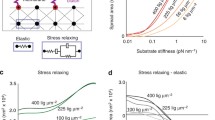Abstract
Cell morphology is controlled in part by physical forces. If the main mechanical properties of cells have been identified and quantitated, the question remains of how the cell structure specifically contributes to these properties. In this context, we addressed the issue of whether cell rheology was altered during cell spreading, taken as a fundamental morphological change. On the experimental side, we used a novel dual micromanipulation system. Individual chick fibroblasts were allowed to spread for varying amounts of time on glass microplates, then their free extremity was aspirated into a micropipet at given pressure levels. Control experiments were also done on suspended cells. On the theoretical side, the cell was modeled as a fluid drop of viscosity μ, bounded by a contractile cortex whose tension above a resting value was taken to be linearly dependent on surface area expansion. The pipet negative pressure was first adjusted to an equilibrium value, corresponding to formation of a static hemispherical cap into the pipet. This allowed computation, through Laplace's law, of the resting tension (τ 0), on the order of 3×10–4 N/m. No difference in τ 0 was found between the different groups of cells studied (suspended, adherent for 5 min, spread for 0.5 h, and spread for 3 h). However, τ 0 was significantly decreased upon treatment of fibroblasts with inhibitors of actin polymerization or myosin function. Then, the pressure was set at 30 mmH2O above the equilibrium pressure. All cells showed a biphasic behavior: (1) a rapid initial entrance corresponding to an increase in surface area, which was used to extract an area expansion elastic modulus (K), in the range of 10–2 N/m; this coefficient was found to increase up to 40% with cell spreading; (2) a more progressive penetration into the pipet, linear with time; this phase, attributed to viscous behavior of the cytoplasm, was used to compute the apparent viscosity (μ, in the range of 2–5×104 Pa s) which was found to increase by as much as twofold with cell spreading. In some experiments the basal force at the cell-microplate interface was quantitated with flexible microplates and found to be around 1 nN, in agreement with values calculated from the model. Taken together, our results indicate a stiffening of fibroblasts upon spreading, possibly correlated with structural organization of the cytoskeleton during this process. This study may help understand better the morphology of fibroblasts and their mechanical role in connective tissue integrity.
Similar content being viewed by others
Author information
Authors and Affiliations
Additional information
Received: 22 June 1998 / Revised version: 14 October 1998 / Accepted: 15 October 1998
Rights and permissions
About this article
Cite this article
Thoumine, O., Cardoso, O. & Meister, JJ. Changes in the mechanical properties of fibroblasts during spreading: a micromanipulation study. Eur Biophys J 28, 222–234 (1999). https://doi.org/10.1007/s002490050203
Issue Date:
DOI: https://doi.org/10.1007/s002490050203




